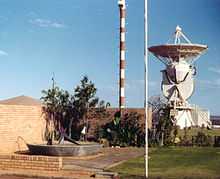Carnarvon Tracking Station

The Carnarvon Tracking Station in Western Australia was a tracking station built in 1963 for use by NASA for the Gemini program, the second step for NASA's plan to put a human on the Moon. It replaced the Muchea Tracking Station and used some of the equipment from Project Mercury.
The Station also included an FPQ-6 precision tracking radar, a STADAN scientific satellite tracking facility, a planet Jupiter monitoring system, and a Solar Particle Alert Network (SPAN) facility. Together these facilities formed the largest station in the NASA network outside mainland USA.
After the conclusion of the Gemini program, Carnarvon Tracking Station provided extensive support for the Project Apollo missions to the Moon. By reason of Carnarvon's unique geographical position it was used to uplink the Trans-lunar injection (TLI) command to the Apollo spacecraft and was prime for the last hours of re-entry to Earth.
To enhance critical communications between the station and the Houston Control Centre, NASA funded the nearby OTC Satellite Earth Station Carnarvon in 1966.
After Project Apollo finished, the Carnarvon Tracking Station continued with the Skylab project. When Skylab finished the station ceased routine operations immediately after an AE-C pass on Friday, 4 October 1974 but retained sufficient capability for one final mission - the trans-solar insertion of Helios-A on 10 December 1974. The final closure of the gates and exodus of the last five staff members took place on 18 April 1975.
The main building was then used by Radio Australia, who were looking for a home after Cyclone Tracy put their Darwin installation out of commission. They closed this facility in June 1996. All Tracking Station equipment was removed and/or buried and all buildings, with the exception of one small one now used by Telstra, were razed. Only the foundations of what is a historical site remain.[1]
Solar scientific research, originally carried out at the Carnarvon Tracking Station, is now carried out on the adjacent OTC Satellite Earth Station Carnarvon site, which hosts a node of the Birmingham Solar Oscillations Network.
See also
- Carnarvon and Apollo: one giant leap for a small Australian town" by Paul Dench & Alison Gregg; Rosenberg, May 2010
- Honeysuckle Creek Tracking Station
References
- ↑ per Terence Kierans, ex-Operations Supervisor and Paul Dench, ex-Chief Engineer and contractor Company Manager
External links
Coordinates: 24°54′15″S 113°43′17″E / 24.90417°S 113.72139°E
- CarnarvonSpace.com Book and website
- Crotrak.com Website